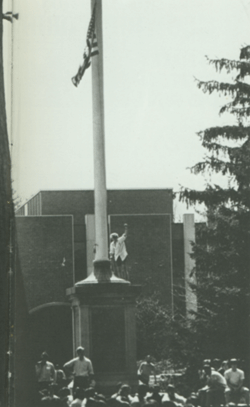A Fresh Look and a Fresh Start: Bowdoin College President Roger Howell and the Student Strike of 1970
On May 4, 1970, National Guardsmen patrolling Kent State University’s campus suddenly turned on an assembled crowd of student protestors and began firing. Less than twenty-four hours after gunfire fatally wounded four of those students, roughly 300 of Bowdoin’s own students met in Moulton Union to discuss a possible strike. Only a decade earlier, higher education flourished as a result of its ability to address both student and societal needs in new and creative ways. By the time Bowdoin College President Roger Howell was inaugurated in 1969, however, students across the nation fully embraced protesting by striking at both large and small institutions to force a realization of change.






A student strike presented the possibility of an unprecedented emergency situation for the College’s young president Howell. Rather than growing hostile in the face of uncertainty, he united with students and faculty and gave them a voice in the process of deciding whether or not to strike. In doing so, he set himself apart from many leaders of higher education institutions during this period. Under his careful watch, the Bowdoin Student Strike unfolded civilly. Howell’s leadership throughout the strike encouraged a spirit of collaboration, allowing Howell to realize his vision for Bowdoin. In his inaugural address, Howell declared that the College would have to acquire a “fresh look and a fresh start” in order to survive the rapid evolution of education in America. Howell’s leadership throughout the strike created the precedent that was necessary to enact positive change at Bowdoin while allowing for the institution to obtain the fresh start that was so crucial to its future.
A special edition of the Bowdoin Orient announced the result of the College community’s 727 to 207 vote in favor of striking. At the all college meeting, Howell joined many students and faculty members in expressing reservations regarding the strike, informing the assembly that he was “not convinced” that a strike was the best way to convey disapproval or apply pressure to the Nixon Administration. Nevertheless, Howell upheld the community’s decision.
The connections Howell forged through his skillful leadership during the strike provided a platform from which he reformed Bowdoin’s curriculum and admissions policies. During his presidency, Bowdoin began to admit women and the College established an Environmental Science program as well as an Afro-American Studies program and African, Asian, and Latin American history courses.
The image of the student protesting on the flag pole undoubtedly concerned parents and alumni who wrote Howell furious letters criticizing his decision to support the student strike. In fact, the strike progressed quite peacefully and many students engaged in constructive protest activities, including letter-writing and door-to-door campaigns, to express their views.
Bowdoin students, seen in the photo above here meeting on the Quad, were not alone in debating whether they should conduct a school-wide strike: many colleges and universities across the country were affected by student protest activities during the spring of 1970.
The connections Howell forged through his skillful leadership during the strike provided a platform from which he reformed Bowdoin’s curriculum and admissions policies. During his presidency, Bowdoin began to admit women and the College established an Environmental Science program as well as an Afro-American Studies program and African, Asian, and Latin American history courses.
On May 5, 1970, Howell issued a joint statement with the Bowdoin Student Council President requesting an all-college meeting later that night. The announcement explained that the meeting’s purpose was “to determine the sentiments and wishes of the College Community on American foreign policy in the East and its impact on the campus.”
Story by Luke McKay and Elyse Terry, '11
Sources: “Strike Ballot” Bowdoin Strike Collection, Bowdoin College Special Collections and Archives; “Strike Edition” The Bowdoin Orient, 5 May 1970; all other images: 1970, Bowdoin College Bugle.